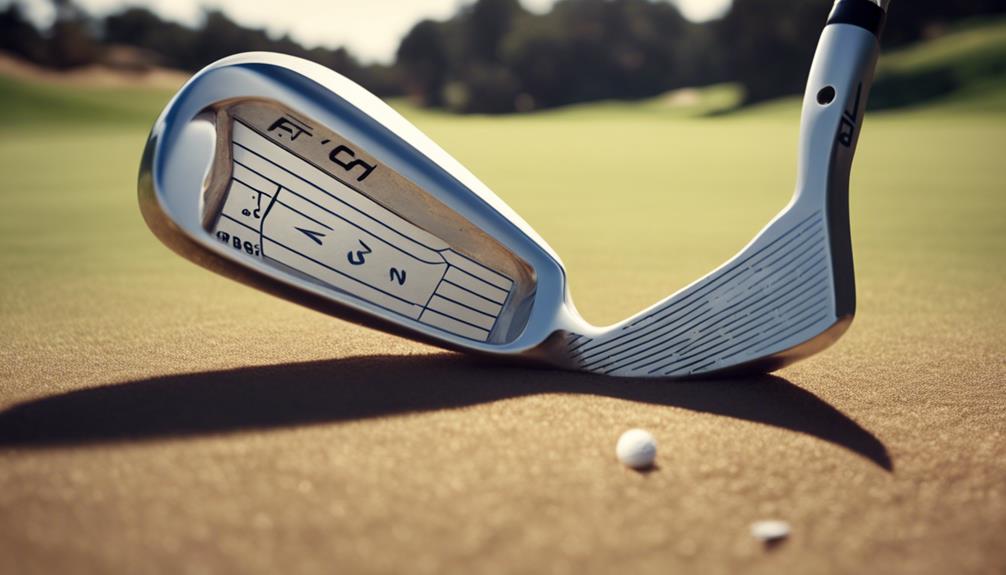- 7 Top Flite Golf Clubs XL for Improved Performance - September 28, 2024
- Top Flite Golf Clubs: Top 5 Reasons to Choose Them - September 28, 2024
- Top 3 Golf Club Fitters for a Perfect Swing - September 28, 2024
You're likely familiar with golf clubs like the pitching wedge and sand wedge, but you're now considering the A-Wedge, a gap wedge that fills a specific distance gap between these two clubs. The A-Wedge provides control over distance and trajectory into the green, making it essential for golfers of all levels. With a loft ranging from 46 to 54 degrees, it's designed for shorter, softer shots that require more accuracy. To get the most out of this club, you'll need to understand its purpose, loft, and ideal use cases – and there's more to learn about this versatile club that can take your game to the next level.
Key Takeaways
- The A-Wedge club fills the gap between the pitching wedge and sand wedge, allowing for shorter, softer shots with more precision.
- The 'A' in A-Wedge stands for either 'approach' or 'attack', and the club can be identified by the 'A' or 'AW' stamp on the sole near the toe.
- With a loft ranging from 46 to 54 degrees, the A-Wedge provides more precise control over approach shots, making it more versatile than the pitching wedge and sand wedge.
- The A-Wedge is designed for shots requiring precision and control, typically from 80-100 yards out, with a higher trajectory and more spin compared to the Pitching Wedge.
- The right A-Wedge can improve overall game performance and provide more precise control over approach shots, filling the distance gap between the pitching wedge and sand wedge.
Understanding the A-Wedge Club
When you're looking to make shorter, softer shots with more precision, the A-Wedge club is the perfect tool to have in your golf bag, filling a specific gap in your arsenal between the pitching wedge and sand wedge.
As a gap wedge, the A-Wedge allows you to control both distance and trajectory into the green, making it an essential club for golfers of all levels.
The 'A' in A-Wedge stands for either 'approach' or 'attack', and you can identify the club by the 'A' or 'AW' stamp on the sole near the toe or the degrees of loft stamped on it.
With a loft ranging from 46 to 54 degrees, the A-Wedge provides more precise control over your approach shots, making it more versatile than the pitching wedge and sand wedge.
Unlike the pitching wedge, which is used for longer shots, the A-Wedge is designed for shorter, softer shots that require more accuracy.
Purpose and Loft Explained
As you explore the purpose and loft of a golf club, you'll discover that the angle of attack matters, affecting how the club face loft angle interacts with the ball.
This interaction is vital for ball flight control, which is essential for achieving the desired trajectory and distance.
Angle of Attack Matters
You'll quickly discover that the angle of attack with an A-Wedge is vital, because its loft determines the trajectory and spin of your shot, making it essential to understand how to use it effectively.
As an approach wedge, the A-Wedge's loft degree, ranging from 46 to 54 degrees, allows you to fill the gap between your pitching wedge and sand wedge.
This precision is imperative, as a slight variation in angle of attack can profoundly impact the outcome of your shot.
When using an A-Wedge, you'll need to adjust your swing to accommodate its unique loft, taking into account the situation and the terrain.
For instance, a steeper angle of attack is required for fairway and rough shots, while a shallower angle is better suited for long bunker shots.
Club Face Loft Angle
With its loft angle ranging from 48 to 51 degrees, the A-Wedge's club face is precision-engineered to fill a critical distance gap between the Pitching Wedge and Sand Wedge.
As you consider your iron set, you'll notice the A-Wedge's loft angle is higher than the Pitching Wedge, typically around 46 degrees, but lower than the Sand Wedge, which ranges from 54 to 58 degrees.
The standard loft angle for an A-Wedge is around 50-51 degrees, but this can vary depending on the iron set design and intended use.
The loft angle of your A-Wedge determines its usage and effectiveness. A higher loft angle results in a higher trajectory and shorter distance, while a lower loft angle yields a lower trajectory and longer distance.
By understanding the loft angle of your A-Wedge, you can make more precise shots and fill the gap between your Pitching Wedge and Sand Wedge.
As a gap wedge, the A-Wedge's primary purpose is to provide a consistent distance gap, allowing you to make more accurate shots and improve your overall game.
Ball Flight Control
By mastering the A-Wedge's loft, you can take precise control of your ball flight, achieving the perfect trajectory to tackle challenging shots and get out of tricky situations.
This club's unique loft, typically ranging from 46 to 54 degrees, fills the distance gap between the pitching wedge and sand wedge, allowing you to hit shots with more precision and control.
With an A-Wedge, you can hit shorter and softer shots than with a pitching wedge, making it an essential club for improving your approach shots.
Whether you're facing fairway and rough shots or long bunker shots, the A-Wedge provides the necessary height and spin to get you out of trouble.
By understanding the standard loft of 50 to 52 degrees, you can choose the right A-Wedge or traditional wedge for your game.
Wedge Types and Uses

As you explore the world of wedges, you'll find that each type serves a specific purpose, and understanding their unique characteristics is key to mastering your short game.
Pitching wedges have a distinct angle that allows for full shots onto the green from 100-120 yards, while gap wedges fill the distance gap with precise shots from 80-100 yards.
Pitching Wedge Angle
Mastering the ideal pitching wedge angle is essential for golfers to achieve consistent, controlled shots that stop quickly on the green.
As you work with your pitching wedge, you'll find it's a versatile club that serves as the final and most lofted club in modern iron sets. With a typical loft of 44-48 degrees, it's perfect for full shots onto the green from 100-120 yards, as well as short pitch and run shots around the green.
To get the most out of your pitching wedge, it's vital to understand its role in your bag.
Unlike lob wedges, which are used for high-arcing shots, your pitching wedge is designed for more controlled, lower-flying shots. When used correctly, it can provide a consistent distance gap between your longest iron and the next highest lofted wedge, usually the gap or approach wedge.
Gap Wedge Distances
Gap Wedges, with their higher loft and more spin, fill a key distance gap in your short game, allowing you to tackle shots that require a higher trajectory and shorter distance than a Pitching Wedge but longer than a Sand Wedge.
The distance a Gap Wedge can achieve depends on your skill level.
Beginners: 60-80 yards
Intermediate golfers: 80-100 yards
Professional golfers: over 115 yards
Average distance: 90-105 yards
Gap Wedges are designed to fill the distance gap between the Pitching Wedge and Sand Wedge, providing a consistent distance gap between the two clubs.
With a loft of 48-52 degrees, Gap Wedges offer more spin and a higher trajectory than a Pitching Wedge (44-48 degrees) but less than a Sand Wedge (54-58 degrees).
This makes them ideal for shots from the fairway or rough that require more height and spin than a Pitching Wedge but less than a Sand Wedge.
Degree Differences and Uses
When choosing the right club for your shot, understanding the degree differences between wedges is essential, and the A-Wedge's unique loft angle sets it apart from the Pitching Wedge and Sand Wedge. The A-Wedge, also known as the Gap Wedge, typically has a loft of 48-51 degrees, which is higher than the Pitching Wedge but lower than the Sand Wedge.
Here's a breakdown of the degree differences between wedges:
| Wedge Type | Loft Angle |
|---|---|
| Pitching Wedge | 45-47 degrees |
| A-Wedge (Gap Wedge) | 48-51 degrees |
| Sand Wedge | 52-56 degrees |
The A-Wedge is designed for approach shots from 80-100 yards out, and its higher trajectory and more spin compared to the Pitching Wedge make it ideal for shots that require a softer landing. However, it has less height and spin than the Sand Wedge, making it a great option for shots from the fairway or rough. By understanding the degree differences between wedges, you can choose the right club for your shot and improve your overall game.
Choosing the Right A-Wedge

With a clear understanding of the degree differences between wedges, selecting the right A-Wedge for your game requires careful consideration of several key factors.
You'll want to think about the shape and construction, as A-Wedges often have hollow construction, providing extra distance and forgiveness.
The loft of an A-Wedge is also vital, typically falling between 50 to 52 degrees, but ranging from 46 degrees to 54 degrees.
Comfort and playing style: Do you prefer the performance and forgiveness of an A-Wedge or the precision of a traditional wedge?
Distance gap: Consider the 30-yard gap between your pitching wedge and sand wedge, and how an A-Wedge can fill it.
Loft and bounce angle: Compare these specs to your traditional 50/52-degree wedge to determine which club best suits your swing and playing style.
Sole width and grind: Think about how these factors will affect your shots and overall game.
A-Wedge Vs Pitching Wedge
Understanding the key differences between an A-Wedge and a Pitching Wedge is essential to selecting the right club for your shot, as each is designed to excel in specific situations. When deciding between these two clubs, consider the distance and trajectory you need to achieve.
| Club | Loft | Distance | Trajectory |
|---|---|---|---|
| Pitching Wedge | 46° | 100-120 yards | Lower |
| A-Wedge/Gap Wedge | 48-51° | 80-100 yards | Higher |
As you can see, the A-Wedge or Gap Wedge has a higher loft than the Pitching Wedge, resulting in a higher trajectory and shorter distance. This makes the A-Wedge ideal for shots requiring more precision and control, such as those from 80-100 yards. In contrast, the Pitching Wedge is better suited for shots from 100-120 yards, where a lower trajectory and longer distance are needed. By understanding these key differences, you'll be able to choose the right club for your shot and improve your overall game.
Frequently Asked Questions
What Is an a in Golf Clubs?
When you see an "A" on a golf club, it doesn't refer to the club angle, shaft material, or head design, but rather the type of wedge, like an approach or attack wedge, with a face offset for precise distance and trajectory control.
What Does a Wedge Mean in Golf?
You're about to tap into a vital aspect of your short game: a wedge is a high-lofted club for shots within 100 yards, requiring precise wedge selection, clubhead design consideration, ball positioning, and swing technique mastery to execute high-arc shots with control and precision.
Can You Use a 56 Degree Wedge as a Sand Wedge?
You can definitely use a 56-degree wedge as a sand wedge for bunker shots and sand escapes, considering its high bounce angle and loft; however, club selection also depends on pin placement and your overall strategy.
Is an Approach Wedge a Gap Wedge?
You're wondering if an approach wedge is a gap wedge. The answer is yes, as both clubs serve the same purpose: providing a consistent distance gap between your pitching wedge and sand wedge, influencing shot selection, swing technique, and ball position.
Conclusion
Congratulations, you've made it through the A-Wedge crash course!
Pat yourself on the back, because now you're basically a golf expert (not really, but we won't tell anyone).
Seriously though, choosing the right A-Wedge can make all the difference in your game.
Just remember, it's not about being cool, it's about getting that ball out of the sand and onto the green.
So, go forth and A-Wedge like a pro (or at least, not like a total newbie).




